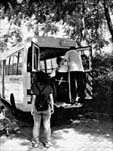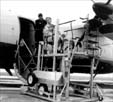
Mobility for all
Getting on board
by Tom Rickert
Entire guide as a PDF file (1.43 MB)
Surface platforms at key sites:
Small mini-platforms at key sites can provide access to trains and trams, as shown in the above left photo from San Francisco. The diagram and photo at right illustrate access to a rail line in San Francisco using this type of platform. A portable bridge is carried in the car and is put in place by the driver. This bridge is kept in a compartment behind the driver.


Smaller vehicles for door-to-door service and service routes
Often one of the first steps in the creation of accessible public transportation is to start an accessible system using vans, small buses, or taxis. In many countries, such systems are operated by social service agencies to serve their clients. In the 1970s, these systems began to serve all qualifying disabled persons in Sweden, the United Kingdom, and elsewhere in much of Europe. Soon these systems spread to North America, and they are now found in some cities on all continents.
These smaller vehicles are usually operated in door-to-door service, called "paratransit" service in North America. Such service is mandated in the United States by the federal Americans with Disabilities Act. Paratransit services are usually operated door-to-door, in order to transport persons with disabilities, including frail elders, between their homes and trip destinations. Fares are usually subsidized by funds from city or state governments.
A second major approach is the use of "service routes," which were first initiated in Sweden. Service routes usually follow a fixed route designed to pass near the homes of seniors and persons with disabilities as well as major trip destinations such as shopping areas, schools, and rehabilitation centers. In some cases, service routes permit their drivers to deviate a short distance from a fixed route in order to pick up a person who has telephoned for service from home. In countries with few telephones, such service works best for recurrent trips, for example, trips taken at the same time on the same day each week.
Both door-to-door service and service routes can provide feeder service to any accessible bus routes or railroad stations.
Because small vehicles are often operated by social service or disability agencies without a great deal of experience in transportation, care should be taken to make sure that vehicles receive scheduled preventive maintenance and that they are scheduled to pick up passengers efficiently. Often it may increase revenues to offer such transportation services to everyone, not just to those with disabilities. This is especially true of service routes.
Increasingly, however, accessible paratransit services and service routes are being operated by public transportation agencies, either using their own drivers or by contracting with social service agencies or private businesses to operate these services.
Whoever operates these services, drivers should be trained to competency in all of their tasks. It is especially important that drivers receive training to assure that they are sensitive to the needs of passengers with disabilities. Such training needs to include the mechanics of how to board and secure persons using wheelchairs. Driver training should always emphasize safe driving.
Other matters to consider when developing a door-to-door system or service routes include:



Ramped taxis
In many countries, it is preferable to have transportation which serves all passengers instead of separate systems for passengers with and without disabilities. One example is the use of ramped taxis. Such vehicles serve all passengers, but can be regulated to give priority to people with disabilities.
The photo at upper left shows a ramped taxi in operation in San Francisco, USA, while the photo in the middle shows one of 10,000 ramped taxis in use in London, UK. Ramped taxis are probably the chief method of transportation for persons with disabilities in London. Such vehicles are gradually coming into use in Europe, Asia, and Central and South America. The photo at upper right shows an artist€s conception of a three-wheeled paratransit vehicle connecting with an accessible "key site" bus stop.
Ramped taxis can provide quick service when telephones are available. Where possible, governments can subsidize fares for disabled persons.

Accessible motorcycles
The photo above shows a three-wheeled motorcycle that have been modified for use by persons with mobility difficulties. The vehicles are produced by Kepha Motorbikes, founded by Wycliffe Kepha in Nairobi, Kenya. It is planned to modify these vehicles further so that a person using a wheelchair can ride in a compartment behind the driver without needing to transfer to a regular seat. Such vehicles could provide low-cost door-to-door service.

Access to horses
In some cases, modifications to saddles can make it easier for those with mobility difficulties to ride horses. The photo is by Joyce Blatherwick, a wheelchair user in rural Montana, USA. The photo above shows some of the special features of her saddle.
Note that the saddle is deeply curved to provide space for a cushion under the rider. Velcro straps on the stirrups and under the rider's shoe help keep legs in place. A handle is added on the back of the saddle to assist in mounting the horse. (See Resources section for information about how to contact Ms. Blatherwick for more information.)
Laws and guidelines
Countries around the world are beginning to provide guidelines and regulations in response to the advocacy of people with disabilities. All countries should consider laws requiring new public facilities to be accessible. This will be a start on the road toward a comp- rehensive legal framework requiring that the built environment and transit vehicles present no obstacles to persons with disabilities.

Access to other modes of travel
Buses, rail cars and smaller vehicles account for most of the trips by public transportation in many countries. This guide can only mention some of the other areas in which people are researching how to make transportation more accessible.